*This post may contain affiliate links. This means we may make a commission if you purchase an item using one of our links*
If you’re a teenager looking into astronomy or even if you’re looking to gift a telescope to your teenage nephew, niece or child you’ve come to the right place. Here we’ll introduce you to the best entry to intermediate options to get your feet wet in astronomy and the art of stargazing.
There are many others equipment and places you can go to dig deeper into this hobby but, the first equipment needed to get started is telescope. That’s why we’ll cover some of our favourites here, all of which are a great setup for this star observing journey.
In A Hurry? Check Out Our 3 Best Picks Below Instead!
Table of Contents




1. Zhumell Z8
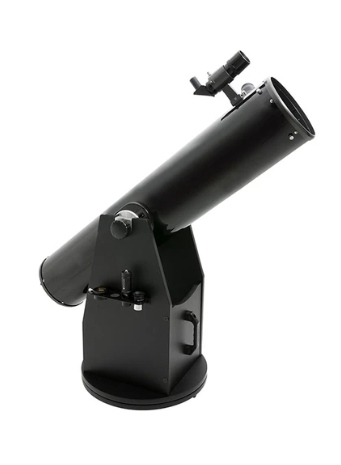
Pros
- Great Power For The Price
- High Quality Dobsonian Mount
- High quality dual speed focuser
- Solid eyepieces included
Cons
- Somewhat heavy
- Regular maintenance required due to the open tube design
Zhumell’s Z8 is an excellent telescope if you’ve got the budget and are comfortable dealing with it’s large and moderately heavy frame.
Of course size and weight aren’t just added for the sake of it, within it you’ll find a quality parabolic mirror optics which will produce sharp and clear visuals of the night sky yet providing a brilliant aperture to price value that’s up there among the best deals you can get.
The main reason the price is in the lower end for the specs you get is due to the cheaper (although competent) dobsonian mount used. This mount can only be moved in one of 4 directions at one time as opposed to at all angles but, with the Z8’s ball bearings design and smooth motion still makes it among the better dob mounts at this price range.
As for the specs, this device has an aperture of 203mm with a focal length of 1200mm resulting in a focal ratio of f/5.9. This is a faster telescope so wider images will be solid and you should theoretically be able to achieve a max magnification of 400x. Keep in mind that the real usable number will be around 10 – 20% lower.
Nevertheless, these specs will allow for some amazing visuals of jupiter, saturn, nebulae star clusters among other celestial phenomenons.
Zhumell also provide good accessories in the box where you’ll get a 30mm wide angle eyepiece and another much narrower eyepiece at 9mm, a dual-speed focuser with a micro-adjusting knob, a quality 9×50 finderscope, and even an included laser collimator.
Overall the Z8 is heavily praised for good reason as it is genuinely a great value based telescope. Therefore if you can find it a good price you certainly cannot go wrong with it.
==>Click Here To Check The Z8’s Pricing On Amazon!
2. Orion SkyQuest XT6
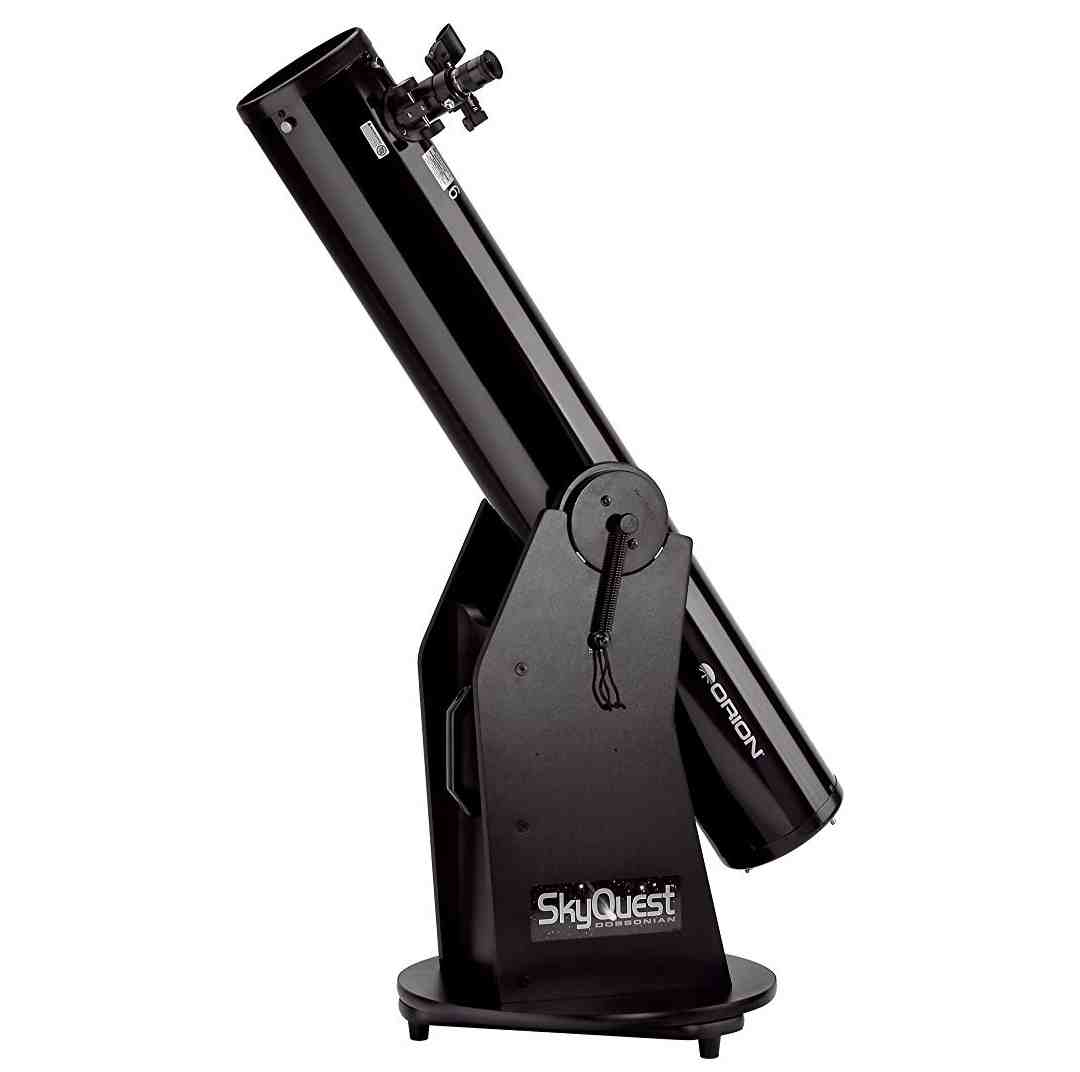
Pros
- Great value for money
- Easy to use
- Easy to set up
- A good 25mm eyepiece
- Easy to collimate
Cons
- Higher levels of maintenance and collimation due to it being a reflector
- The finderscope in the box is poor
- Particle board used
Orion’s skyquest XT6 is another great bang for your buck telescope as it comes with powerful optics at a more than reasonable price.
The specs for this telescope are as such, an aperture of 150mm, a focal length at 1200mm resulting in a focal ratio of f/8. This means the XT6 will be able achieve a max magnification of around 300x with the real usable magnification being around 10 – 20% lower. Nevertheless, these specs will still be awesome for viewing planets, star clusters and a number of other celestial bodies.
Orion provides one 1.25″ plossl eyepieces with a wider 25mm focal length (48x), a 2x Barlow lens, a red dot finderscope and a solar filter in the box. Besides the finderscope not being the greatest as it struggles to fit on the scope sometimes and only one eyepiece being provided, the accessories are genuinely quite good.
Of course this does not mean that upgrading the eyepieces or other items won’t be necessary, particularly if you want the max performance out of the XT6.
Another area where the XT6 cheaps out has to do with the material used on the dobsonian mount. The mount itself is actually good and will provide a relatively smooth experience jumping from one star to another however, the particle board used to make it is prone to rotting so expect the board to potentially rot a little down the line.
There are fixes to this honestly small issue ifbyou do pick up the XT6 nevertheless, other than this and some of the mediocre accessories provided, this device is among the best value for money telescopes out there and would be a great place to start if you truly want to invest in this hobby.
==>Click Here To Check The XT6’s Pricing On Amazon!
3. Skywatcher 6 Inch Dobsonian
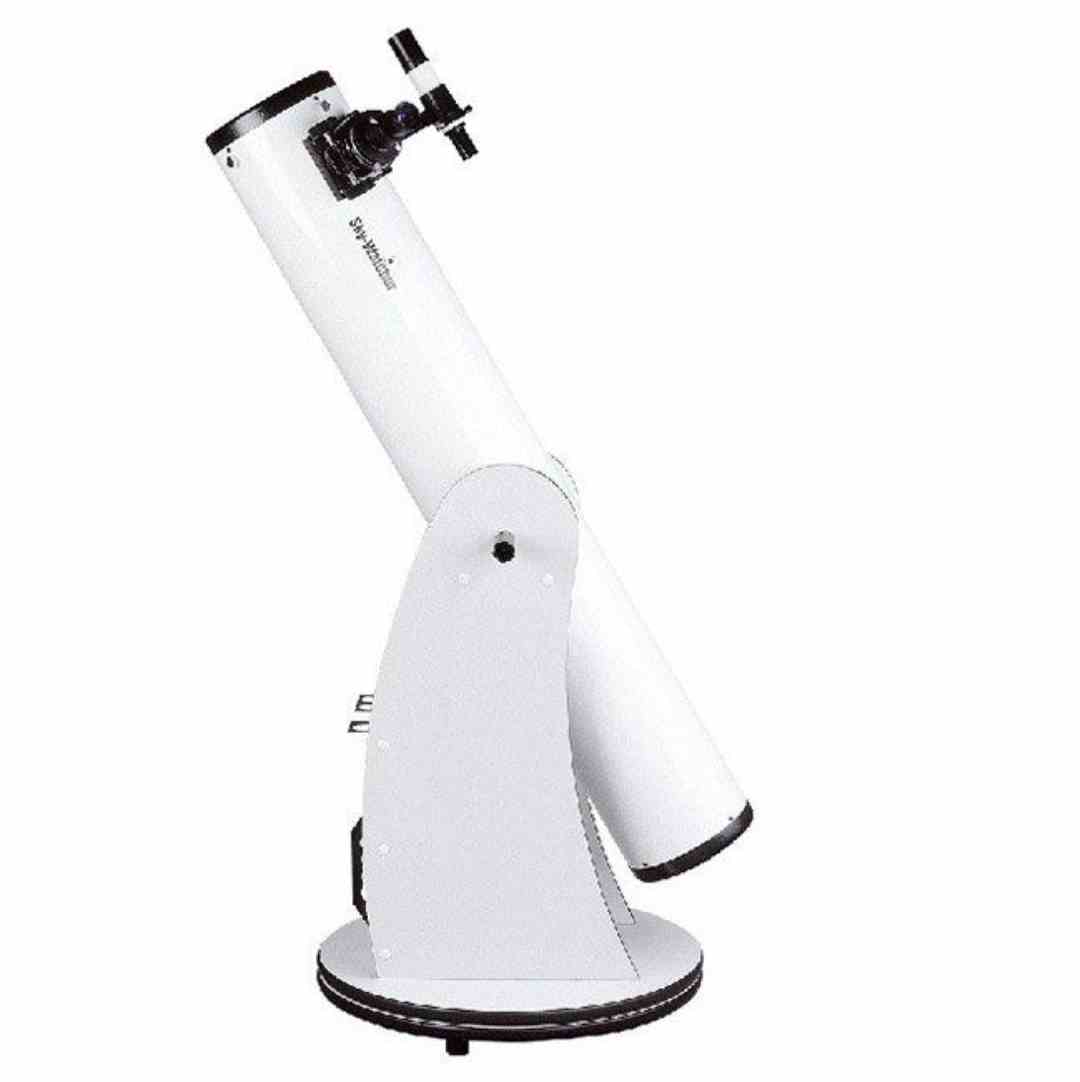
Pros
- Easy to assemble
- Easy to use
- Great accessories
- Great optics for the price
- Great value for money overall
Cons
- Will need to be regularly maintained and collimated
- The finderscope is a bit small
- Particle board used for the mount
The skywatcher 6 inch Dobsonian is yet another hyped up telescope and for good reason. If you can find it at a good price the skywatcher is among the best bang for your buck telescopes in the market with great optics, good accessories and a pleasing design. Of course having 6 inch optics does make it a little larger and heftier than other alternatives.
With an aperture of 153mm, a focal length of 1200mm resulting in a fairly narrow focal ratio of f/7.8, the skywatcher will be able to achieve a usable magnification of around 250x although it can technically achieve a max value of around 300x. This means you will be able to see a good number of celestial objects much like the other devices mentioned above.
In terms of accessories, the SkyWatcher 6 comes with a single-speed 2” rack-and-pinion focuser made mostly of metal, two 1.25” Super eyepieces that are very similar to Plossls which includes a 25mm (48x) and 10mm (120x) eyepieces, a basic 6×30 finderscope and a bunch of miscellaneous documents.
In this case other than the lower quality finderscope (you’ll likely want to upgrade to 9 x50), the eyepieces, focuser etc. are great quality and will provide a solid out of the box experience when observing the night sky.
Once again the dob mount is smooth for movement but, in terms of the materials used the particle board may be an issue later down the road.
As a whole, if you’re interested in another value based proposition, I would highly suggest looking into the SkyWatcher 6, if you can find it at a good price that is.
==>Click Here To Check The SkyWatcher’s Pricing On Amazon!
4. Orion Starblast 4.5 Astro
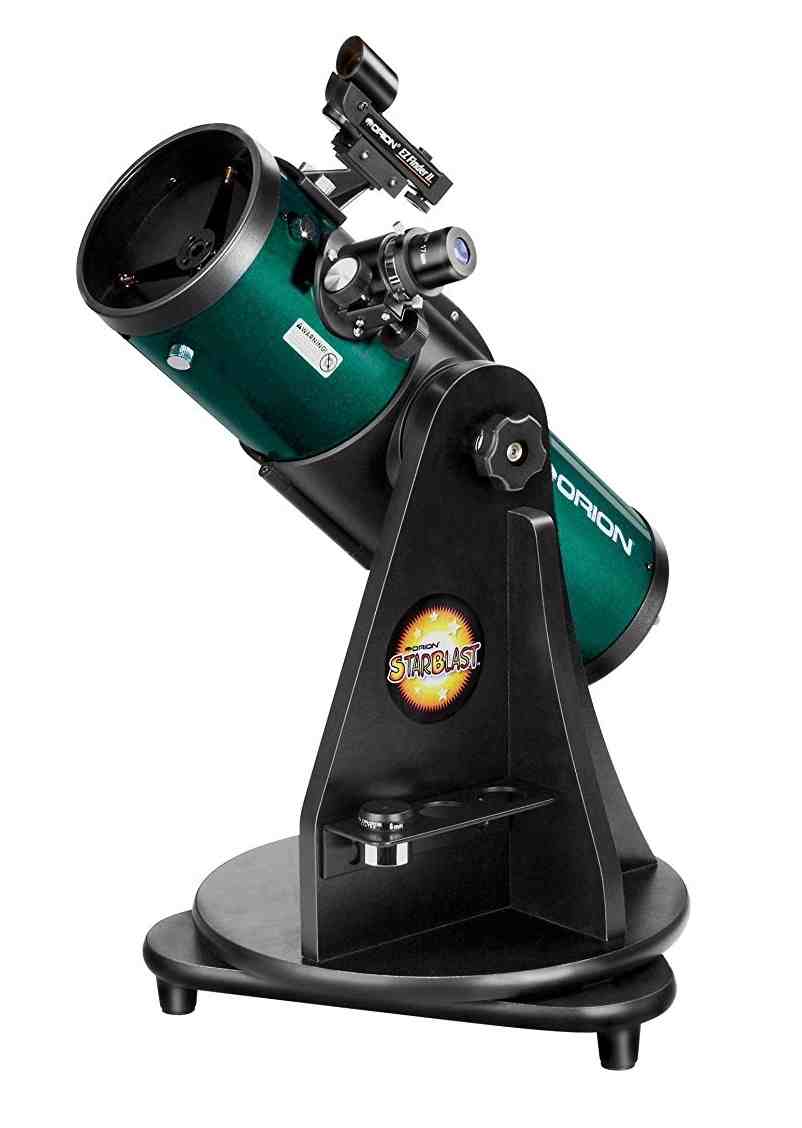
Pros
- Solid optics for the price
- Really portable
- A great tabletop mount
- Reasonably affordable
- Pre-assembled
- Good for beginner level astronomers and children
Cons
- The eyepieces are mediocre
- Will require high maintenance due to exposed optics
- Switching to a tripod will be difficult to do
If you’re looking into a more entry level telescope, Orion’s starblast 4.5 Astro is solid place too start. This device is a tabletop dobsonian meaning it will be more portable than the other telescopes already mentioned whilst it’s performance will also be a good bit worse than them too.
With that being said the starblast 4.5 comes with an aperture of 114mm, the focal length is 450mm resulting in a very fast and wide focal ratio of f/4. The optics used here are also using parabolic mirrors which means focusing and clarity should be reasonable with the starblast.
Although the max magnification will only be around 230x, the device will still be able to a view a good number of celestial objects but, do keep in mind the overall clarity of objects further away will leave a lot to be desired. The starblast is also a very fast telescope so views will generally be wider whilst visual issues like coma will be more visible too.
Two Explorer II 1.25 inch Kellner telescope eyepieces (17mm and 6mm), EZ Finder II reflex sight for easy aiming, eyepiece rack, collimation cap, Starry Night astronomy software, and a few other miscellaneous gear are included in the box.
Other than the eyepieces which are fairly low quality and of course the somewhat cheaper build, orion does include a good bunch of accessories. That being said even if the eyepieces are of a lower quality they’ll still be satisfactory for use although, if you have the budget upgrading would definitely be something to look into.
Overall, Orion’s starblast 4.5 Astro is another good device in the entry level space that will satisfy your needs if you want something a bit more portable yet can also provide a great experience when stargazing.
==>Click Here To Check The 4.5 Astro’s Pricing On Amazon!
5. Celestron Nexstar 127SLT
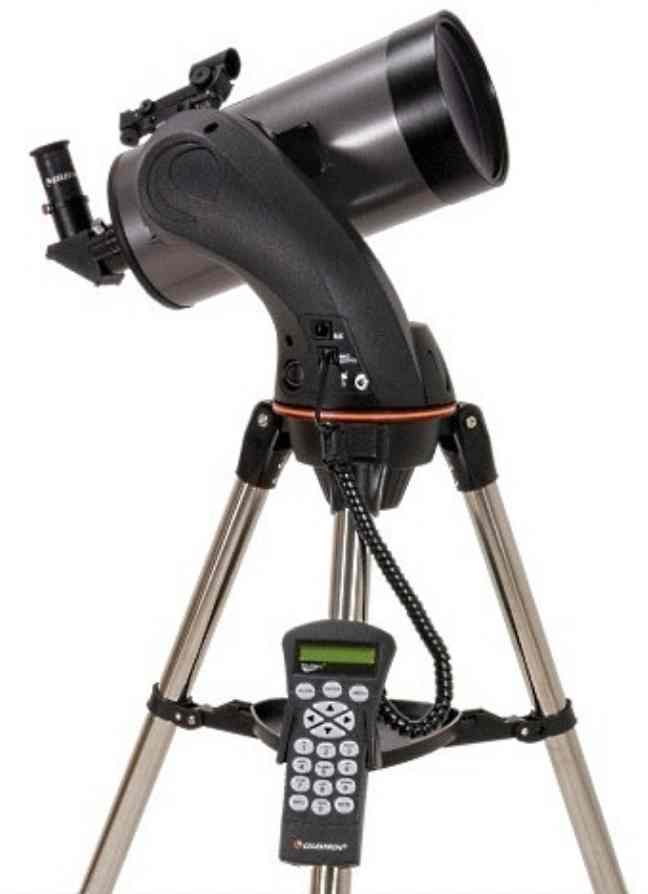
Pros
- Good in box accessories
- Easy to set up
- Solid performance
Cons
- A little pricey
- The mount is somewhat unstable
- The eyepieces provided are sub par
Celestron’s nexstar 127SLT is a part of the entry level computerised telescopes that are offered by this brand. The optics used within are quite bit different to the reflectors recommended previously. This telescope uses maksutov-cassegrain optics within which is in essence an optical design that uses both mirrors and glass within to create an image.
Furthermore, due to the specs this device carries it is also far better suited to planetary viewing. This is because the aperture of 127mm, focal length of 1500mm resulting in a focal ratio of f/12 means the overall views you’ll see will be narrower and in turn more focused on singular objects likes planets or moons.
The negative here is that wider field views will be compromised. This should be fixed to some degree if you look into buying an eyepiece better suited for wide field views.
Computers are the reason why this device is so much more costly than the others mentioned here as the automatic GoTo mount with its database of 10k objects along with a few nifty features like skyalign to help with the focusing and aligning of your optics will make the 127SLT more convenient than its competitors.
That being said you will need to purchase a PowerTank or batteries to power the mount as it isn’t rechargeable.
As for the accessories, you’ll receive two 1.25″ kellner eyepieces at focal lengths of 25mm and 10mm, a starpointer finderscope, a star diagonal, a tripod and a few manuals and other miscellaneous documents. The eyepieces are at the lower end of the value department so they’ll need to be upgraded but, other than that the other accessories are decent enough.
If an automated computermised mount is essential to you as you don’t necessarily want to manually maneuver your telescope to lock on to specific celestial objects, the 127SLT will be an awesome device as not only will the visuals be excellence but, the overall experience will be easier adn as a result StarGazing will be less of chore when setting up.
==>Click Here To Check The 127SLT’s Pricing On Amazon!
6. Celestron Nexstar 5SE
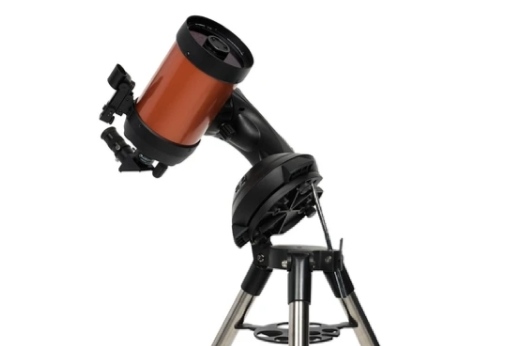
Pros
- The device is very portable
- The GoTo mount is nice and easy to use
- It’s a decent system for astrophotography
- The image quality is solid
- The accessories provided in the box are of solid quality too
Cons
- It’s really expensive
- It not very power efficient
- The boot up process is a little annoying
The nexstar 5se is is mid range nexstar line up and is slightly upgraded variant of the 127slt mentioned. The optics used are the same being the maksutov-cassegrain design whilst the specifications aren’t all that different.
This is because the 5se has an aperture of 125mm with a a focal length of 1250mm which means it does have a pretty narrow focal ratio of f/10. The focal ratio means planet views will be one of its stronger features whilst its astrophotography abilities are benefited too due to the more detail captured.
It’ll be able to achieve usable magnification of around 200x so great views of jupiter, saturn, nebulaes among other celestial object will be possible although certainly not as detailed as the bigger scopes on this list.
Celestron’s provides a GoTo mount with a database of over 40k celestial objects so it is slightly more premium computerised mount. It does have a few quirks that aren’t the best such as non rechargeable battery and the system requires you to put in the date and time everytime the device is switched off nevertheless, these shouldn’t affect performance all that much.
As for the other accessories celestron provides a red dot StarPointer finderscope, 25mm Plossl eyepiece, visual back, and a mirror star diagonal. Honestly the number of items provided is very limited and you probably will need to purchase more eyepieces to get the most out of the 5se’s performance but, for what they’re worth the accessories are good enough.
Computerise aare obviously far more costly than similary powered telescope due to their multitude benefits and I guess hacks for finding celestial objects so, if you feel like automated assistance (to a degree) is important to your astronomy session, the 5se will be an excellent telescope to look into.
==>Click Here To Check The 5SE’s Pricing On Amazon!
7. Orion AstroView 120ST

Pros
- Very portable for the size of the optics
- Good specs
- Nice inbox accessories
- Lower maintenance
- Easy to set up
- Solid beginner level astrophotography telescope
Cons
- Chromatic aberration will be quite prevalent
- It’s expensive
- Finderscope is sub par
Orion’s AstroView 120ST is another great device utilising refractor optics this time enclosed within its chassis. Unlike reflector telescopes, refractors require less maintenance meaning less necessity for having to align the optics (more consistent clarity) and even to some degree better durability.
Of course this is only a smaller pro over reflector telescopes. There is a con attached to the 120ST’s specific achromatic refractor glass lens used which is that false colours/chromatic aberration will be visible on most objects, which to explain it briefly produces flase rainbow like colours on a good number of celestial objects.
With an aperture of 120mm, a focal length of 600mm resulting in a fairly wide focal ratio of f/5, it does mean chromatic aberration will be very visible on 120ST. Nevertheless, the better clarity over the other rrflector telescopes does mean you’ll be able to achieve around 240x in max magnification.
This obviously isn’t the best performance in this price range or category but, if Orion’s AstroView 120ST is one you’re keen on purchasing it’ll do the job more than well enough as a first time device.
Orion includes two Sirius Plossl 1.25″ eyepieces (25mm and 10mm), a 6×30 finder scope, a 2″ rack and pinion focuser, 90-degree mirror star diagonal, Orion’s Starry Night astronomy software along with a bunch of other miscellaneous documentation. Other than the very subpar finderscope all of the other accessories included are genuinely good.
The mount used is an equitorial mount so expect to have full motion when manually adjusting your position for StarGazing. In fact this mount is definitely one of the AstroView’a best features meaning adjusting and positioning for the best views should be a breeze.
If you can handle the few minor shortcomings, much like every other telescope on this list, the AstroView 120ST will not dissapoint and may serve some you well for many years to come.
==>Click Here To Check The 120ST’s Pricing On Amazon!
8. Skywatcher 8 inch Flextube/collapsible
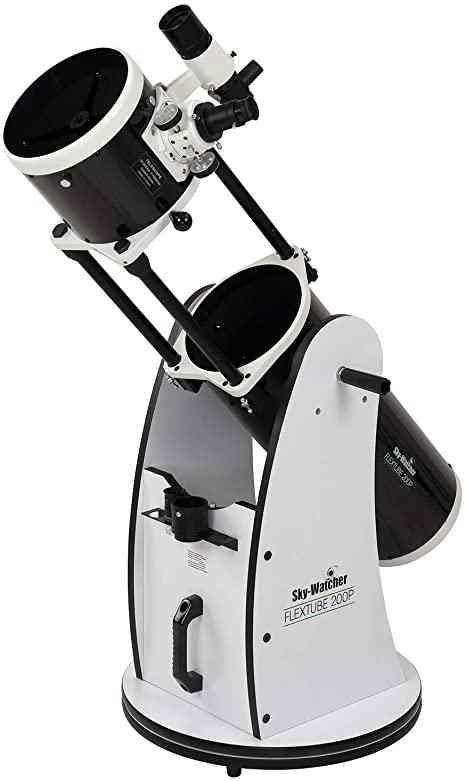
Pros
- Can be separated into two pieces for easier storage and portability
- Great in box accessories
- Great specs
- Great mount
Cons
- Very heavy despite its portability
- Issues with part maintenance
- Hard to collimate, specifically for new users
- Will require a fair bit of maintenance
SkyWatcher’s 8 inch Flextube/collapsible is basically an 8 inch telescope that can have its optics collapsed to reduce the overall footprint of the device. It’ll mostly diminish height based problems but a shorter does mean you’ll have an easier time putting this large bit of kit away.
Other than this the optics used are newtonian reflector based meaning a parabolic mirror is used resulting in sharper visuals than cheaper alternatives.
The specs are solid too with skywatcher’s flextube having an aperture of 203mm, a focal length of 1200mm resulting in a focal ratio of f/6.
As a result the flextube can view up to a max magnification of around 400x whilst the faster focal ratio makes the device better for wider field views although it also means coma, diffraction, among other minor visual discrepancies will be more noticeable.
Performance and the quality of the visuals shouldn’t be hindered all that much as detailed views of multiple planets in our solar system among other celestial objects will be viewable through the eyepieces, provided you purchase eyepieces to get the most out of this devices performances.
Speaking of eyepieces skywatcher bundle a number of accessories with the Flextube where you’ll be given 2 1.25 inch Plossl eyepieces at 25mm(48x) and 10mm(120x), a 2” Crayford focuser with a 1.25” adapter, a 8×50 finderscope, an eyepiece tray and a bunch of other miscellaneous documents.
All of these items are genuinely great for in box accessories although, as mentioned above certain upgrades may be necessary to get the most out of your purchase.
Once again the mount used here is solid but is made of particle board, which is known to have lackluster durability. Nevertheless, another issue is that maintenance will more time consuming but, if you just want a very capable telescope that’s a good bit more portable than other 8 incher’s, the Flextube isn’t one you should pass up on.
==>Click Here To Check The Flextube’s Pricing On Amazon!
9. Zhumell Z10
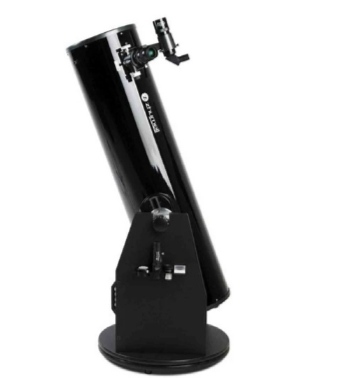
Pros
- Great specs for the price
- Great accessories included
- Easy to set up
Cons
- Will require regular maintenance and collimation
- It’s really big and quite heavy
Zhumell’s Z10 is just a bigger Z8 so expect to see slightly better visuals than its smaller counterpart. Of course the larger optics also means it’ll be a lot larger and heavier than the aforementioned device so, only invest in this if you have enough space to store or it and can handle the extra heft when it comes to moving it around.
Speaking of which the Z10 has arguably the best optics on this list or at the very least the most powerful number wise. It comes with an aperture of 254mm aperture, a focal length of 1250mm resulting in a fairly wide focal ratio of f/5. Max magnification will be around 500x but, the real usable number will be around 10 or so percent less.
Of course this will hardly hinder the over-all performance because the large optics will be provide exemplary details on the celestial objects you wish to see. At the very least they should be the best out of the bunch here.
The Zhumell Z10’s mount is the same as was provided with the Z8 with the design using ball bearings. Motion of course will be smooth even though as is the case with dobsonian’s it will only move in 1 of 4 directions at one time.
Zhumell provides similar accessories too where 2 eyepieces, one 2″ fully coated 30mm eyepiece and another 1.25″ 9mm eyepiece, a dual Crayford focuser, a 8×50 Finderscope, a Laser Collimator, a 1.25″ moon filter along with a few other books and miscellaneous documentation are included in the box.
These are once again great inbox items and will allow for an awesome stargazing experience right out of the box but, much like every device on this list buying more competent eyepieces to utilise more of the Z10’s power will be necessary down the road, if you want to get the most out of the device.
In short, if you simply want a high quality 10″ telescope at a really good price, the Z10 is among the best if not the best value for money at this optical size.
==>Click Here To Check The Z10’s Pricing On Amazon!
Conclusion
Every device on this list have their pros and cons and for the most part, depending on where you budget lies, you will enjoy yourself no matter which device you pick.
If you value a more portable experience the smaller telescopes is where you should look, if you simply want the best value to performance ratio the larger dobsonian telescopes are always excellent telescopes to look into whilst the computerised options are great if you want a little more help on your stargazing endeavours.
Either way, if you’re looking into astronomy or if you’re looking to buy one for your teenager, this list has laid out some of our favourite options. Therefore if you do bite the bullet and purchase a telescope that suits your values, I’m certain that you won’t be disappointed.
A Reminder Of Our 3 Favourites!





